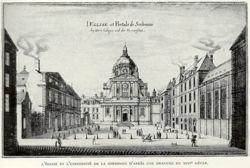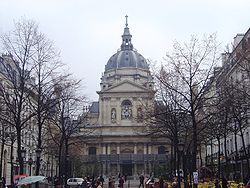- Collège de Sorbonne
-
The Collège de Sorbonne was a theological college of the University of Paris, founded in 1257 by Robert de Sorbon, after whom it is named.[1] With the rest of the Paris colleges, it was suppressed during the French Revolution. It was restored in 1808 but finally closed in 1882. The name Sorbonne eventually became synonymous with the Parisian Faculty of Theology. In more recent time, it came to be used in reference to the entire University of Paris. It is now the name of the main campus in the Ve arrondissement of Paris, which houses several universities (heirs to the former University of Paris) as well as the Paris rectorate.
The College was originally a graduate college. It was planned for graduates who had already acquired a degree of M.A. and were taking courses leading to the doctorate in theology.[2] It quickly built a prestigious reputation as a center for learning. By the 13th century, there were as many as twenty thousand foreign students resident in the city, making Paris the capital of knowledge of the Western world. Today, foreign students still make up a significant part of its campus.
The Sorbonne became the most distinguished theological institution in France, and its doctors were frequently called upon to render opinions on important ecclesiastical and theological issues. In 1622–1626, Cardinal Richelieu renovated the Sorbonne; the present buildings date from this time, with later restorations dating from 1885. In his honour, the chapel of the Sorbonne was added in 1637. When Richelieu died in 1642, he was interred in a tomb in this chapel.
The faculty's close association with the Church resulted in its being closed down during the French Revolution, which had strong anti-clerical sentiment. Napoleon reopened it in 1808 to serve as part of the University of Paris. Between then and 1885, the Sorbonne served as the seat of the university's theology faculties and of the Académie de Paris. At the end of the 19th century, the Sorbonne became an entirely secular institution.
Contents
Foundation
Robert de Sorbon was a native of Le Réthelois, a distinguished professor and famous preacher who lived from 1201 till 1274. Sorbon found that there was a defect in the primitive organization of the University of Paris. The two principal mendicant orders—the Dominicans and the Franciscans—each had colleges at Paris where they delivered lectures which extern students could attend without fee.
Robert de Sorbon decided that the university should also provide free instruction, so that it could compete with the religious orders. Further, he believed the society of professors should follow the practices of the cenobitic life, except in vows. His important work was made possible by the high esteem in which de Sorbon was held at Paris, together with his intellectual brilliance, great generosity, and the assistance of his friends. The foundation dates from 1257 or the beginning of 1258. Guillaume de Saint-Amour, Gérard d'Abbeville, Henry of Ghent, Guillaume des Grez, Odo or Eudes of Douai, Chrétien de Beauvais, Gérard de Reims, Nicolas de Bar were among the most illustrious scholars connected either with the first chairs in the Sorbonne, or with the first association that constituted it. These savants were already attached to the university staff.
Organization
The constitution of the society as conceived by De Sorbon was simple: an administrator (provisor), associates (socii), and guests (hospites). The provisor was the head; nothing could be done without consulting him; he installed the members selected by the society, and confirmed the statutes drawn up by it; he had to provide for everything.
The associates formed the body of the society. To be admitted to it, the candidate was required to have taught a course of philosophy. There were two kinds of associates, the bursaires and the pensionnaires. The latter paid forty (Paris) pounds a year; the former were provided for by the house. The burse could be granted only to persons not having an income of forty (Paris) pounds. There was a primus inter pares, the prior, who presided over all internal affairs of the house.
Doctors and bachelors were alike eligible, but, owing to the number of the latter, the custom rapidly grew up of selecting only bachelors. Other persons were candidates for admission to the society rather than members of it. From the material and intellectual point of view, they enjoyed the same privileges as the members: board, lodging, books, spiritual and scholastic exercises but they had no votes. When they had fulfilled the condition of teaching philosophy, they were admissible as members. The course of studies lasted ten years, during which time their burses continued; but if, at the end of ten years, they had not given proof of their ability, either as teachers or as preachers, they had to give up their burse.
History
The ordinary lectures were public, and consequently were attended by students who belonged to neither of the divisions of the society. The doctors and bachelors were authorized to give shelter to other poor pupils. Besides the work of the classroom, there was the duty of preaching or labouring in the parishes. In preparation for this, the associates, on certain days, had to deliver sermons or conferences (collationes) to the community. The purely spiritual side was not forgotten. Conferences, usually delivered by the prior, on this important part of the Christian and priestly life were given especially to the interns.
For twenty years the ability of the administrator, or provisor, corresponded to the foreseeing devotedness of the founder. This stretch of time showed the effectiveness of the administrative measures which De Sorbon had adopted. He had written down the rules in thirty-eight articles. This rule was directed towards the maintenance of common life, from silence in the refectory, to simplicity of authorized dress. As circumstances permitted, about 1271 De Sorbon added a literary college: this was the Collège de Calvi or the "little Sorbonne".
The constitution which Robert de Sorbon gave to his college lasted for centuries. If Claude Héméré (1574–1650, librarian of the Sorbonne) saw in the project the conception of a powerful intellect, "Hoc primus in lycaeo Parisiensi vidit Robertus", its realization became a model college for others. The expression Pauvres maîtres et étudiants en théologie seems to emphasize the two primary characteristics of the society: equality in poverty, an equality so perfect between masters and pupils that it designated them by a common name; the poverty of the pupils, since most of them were bursaires; the poverty of the masters, since, content with what was strictly necessary, they renounced all other professional remuneration. This equality was always maintained with scrupulous care; the Sorbon repeated as an axiom, Omnes nos sumus socii et aequales, and referred to the college as pauperem nostram Sorbonem.
From the outset the college enjoyed the favour of the Holy See. Pope Alexander IV (1259) urged the French bishops to support it, Urban IV (1262) recommended it to the goodwill of the whole Christian world, and Clement IV (1268) granted it papal approbation. Wealthy benefactors provided it with ample endowment. A high standard of scholarship was maintained and the severity of the actus Sorbonnicus, or examination for degrees, including the defence of the "thesis Robertina", became proverbial. The professorial corps was highly respected. From all parts of Europe, theological and political questions were sent to it for solution.
In 1470 the Sorbonne introduced the art of printing into France by calling to Paris three of Gutenberg's associates, Gering, Friburger, and Crantz. Among its principal patrons and benefactors was Cardinal Richelieu, who held for a time the office of provisor and who, in 1635, laid the cornerstone of an edifice to be built at his expense for the use of the college. He was buried in the church of the Sorbonne, where his tomb is still preserved.
The doctors of the college were loyal defenders of the Catholic faith against the inroads of Protestantism and the Enlightenment. As other teachers of theology in the university became members of the Sorbonne, by the beginning of the sixteenth century, its staff was practically identical with the university faculty. De Sorbon had created a library. It expanded rapidly, due to numerous gifts.
On the other hand the professors gave their support to Gallicanism and obliged their members to subscribe to the "four articles". This attitude naturally weakened the prestige of the Sorbonne as a theological school. Ecclesiastical students had to seek their education in the seminaries. The Sorbonne itself was suppressed by decree of 5 April 1792, after the French Revolution.
Napoleon restored it in 1808 as the theological faculty of the newly organized university. It did not, however, regain its former standing or influence, though it continued in existence until 1882, when it was finally suppressed. In 1884 the construction of the present building was begun and it was completed in 1889. At the beginning of the 20th century, it was occupied by the various departments of letters and science which formed the École des Hautes Etudes.
Accomplished students
- Antoine Arnauld
- Hardouin de Beaumont de Péréfixe, Bishop of Rodez
- Pope Clement VI
- Jean-Baptiste Dubos, historian and critic, Perpetual Secretary of the Académie française
- André Duval, Dean of the Paris School of Catholic Theology
- Philippe de Gamaches, theologian, first Chair of Theology at the Sorbonne
- Jérôme-Claude Gandolphe, delegate to the National Constituent Assembly
- Charles Gobinet, religious writer and teacher, early principal of the Collège du Plessis
- Jean Gobinet, theologian, early principal of the collège du Plessis
- Joseph Hook
- Jacques Lescot, Bishop of Chartres, principal of the Collège de Dainville
- Gabriel de Nail, Great bard of Amiens
- Louis-Antoine de Noailles, Archbishop of Paris
- Jean-Jacques Olier, founder of the Society of Saint-Sulpice
- Nicole Oresme, Old master of the Collège de Navarre
- Armand Jean du Plessis de Richelieu, Cardinal de Richelieu and chief minister to Louis XIII
- Edmond Richer
- Pierre Sigorgne, High vicar of the Diocese of Macon, correspondent for the Institute
- Pierre-François Tinthoin
- Madame Wei Tao-Ming (Chen Yu-Hsiu)
- Thomas of Ireland, author of the popular florilegium Manipulus florum.[3]
See also
References
- ^ De Ridder-Symoens, Hilde. A History of the University in Europe: Volume 1, Universities in the Middle Ages. Cambridge, U.K.: Cambridge University Press, 2003: 80. ISBN 0521541131
- ^ Coban, Alan B. The Medieval Universities: Their Development and Organization. London: Methuen, 1975: 127.
- ^ Chris L. Nighman, "Commonplaces on preaching among commonplaces for preaching? The topic Predicatio in Thomas of Ireland's Manipulus florum", Medieval Sermon Studies 49 (2005), 37-57.
 This article incorporates text from a publication now in the public domain: Herbermann, Charles, ed (1913). "Sorbonne". Catholic Encyclopedia. Robert Appleton Company.
This article incorporates text from a publication now in the public domain: Herbermann, Charles, ed (1913). "Sorbonne". Catholic Encyclopedia. Robert Appleton Company.External links
Categories:- Colleges of the University of Paris
- 1257 establishments
Wikimedia Foundation. 2010.


